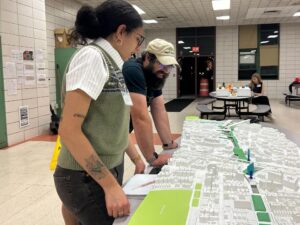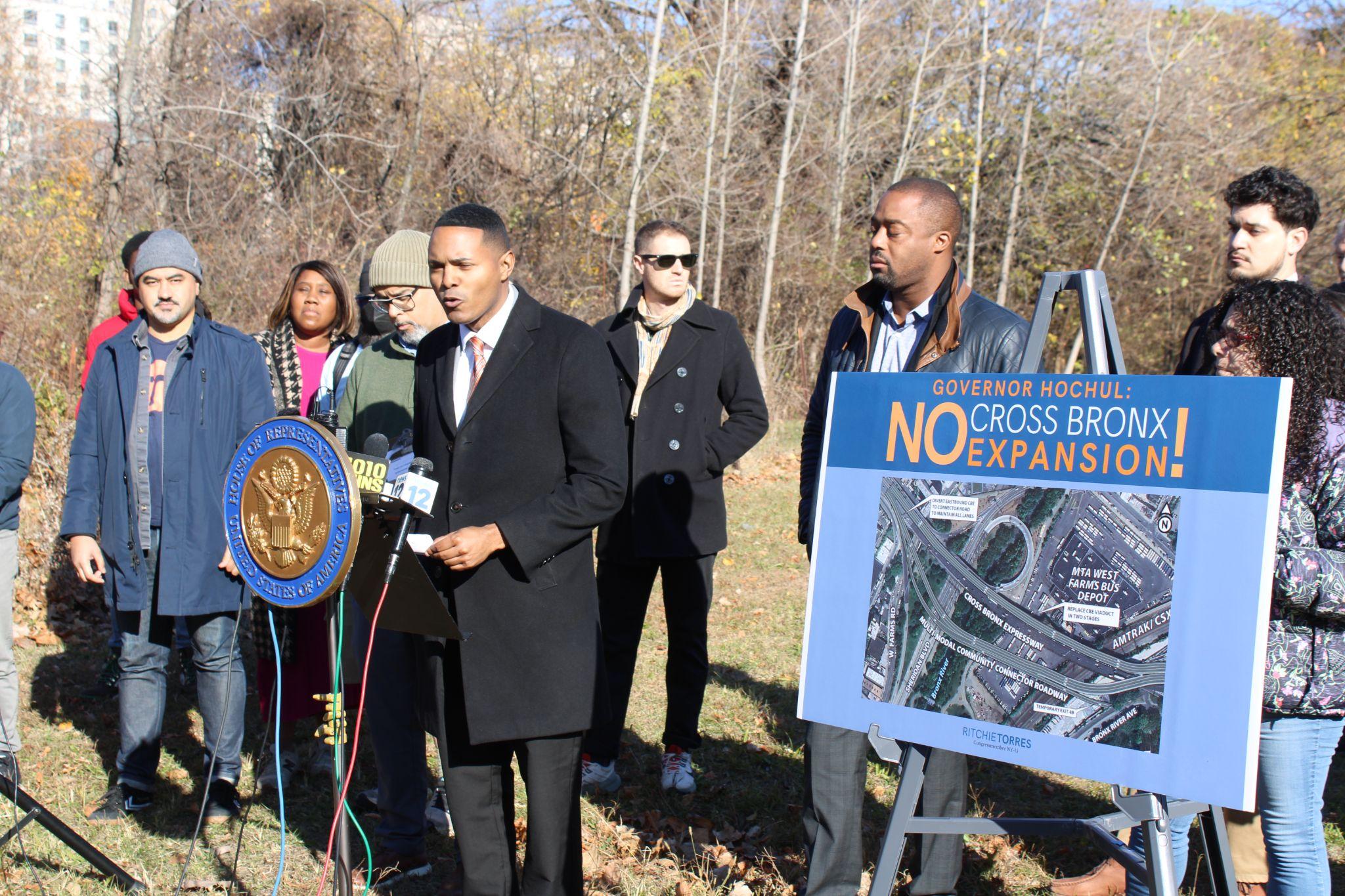A plan to expand the Cross-Bronx Expressway through a mile-long ‘connector’ road has incensed South Bronx activists, many of whom have long been involved in projects to reduce the environmental impact of the borough’s many highways.
Gov. Hochul’s push for construction of a new mile-long section of the Cross Bronx Expressway has drawn the ire of elected officials, community organizations and residents, who say the project is unnecessary and will worsen health outcomes in the borough.
The $900 million taxpayer-funded project calls for the repair of five bridges over the Cross Bronx, as well as the construction of a ‘connector’ road running parallel to the expressway from Boston Road to Rosedale Avenue, passing over the Bronx River.
“We just feel it really works against what the community was looking for in terms of reimagining the Cross Bronx, in terms of reducing air pollution,” said Nilka Martell, founder of Loving the Bronx, who has long called for reducing the expressway’s impact on the neighborhoods it cuts through. The South Bronx has the city’s highest rates of asthma and the most pediatric emergency room visits for asthma – more than 500 visits per 10,000 children, according to a 2020 study by the International Journal of Environmental Research and Public Health.
The new roadway earned swift condemnation from Bronx environmentalists, who have fought for a generation against the highways that crisscross the South Bronx. Bronx River Alliance held a press conference in Starlight Park on November 25 to publicly oppose the plan, which they fear will increase air pollution and exacerbate the problem for those who suffer with asthma.
“Any project to replace the Cross Bronx needs to improve air quality by reducing asthma, improve the health of the river by reducing stormwater and transform how local communities use transit,” said Siddartha Sanchez, executive director of the Bronx River Alliance. “This can best be accomplished by changing how the Cross Bronx and neighboring roads are used, not by building more highways.”
The state transportation department is currently conducting an environmental assessment for the project, which will be released later this month. But Bronx Community Board 6 District Manager Rafael Moure-Punnett is concerned the community may not have a say during the 30-day commenting period after the study is published.
“We have yet to get commitments from the state around what the community engagement will be during that 30-day period,” said Moure-Punnett. “And what we’re worried about is they publish it in December on the 29th day, they hold the town hall, and then they close the period.”
Congressman Ritchie Torres, Assemblymember Landon Dias, and Assemblymember-elect Emerita Torres also spoke at the November 25 rally, which followed a Nov. 13 letter by Rep. Torres and Rep. Alexandria Ocasio-Cortez, criticizing the connector road plan.
“The Hochul administration is intent on expanding the Cross Bronx Expressway at the expense of public health here in the Bronx,” said Rep. Torres. “The expansion of the Cross Bronx will mean more diesel truck traffic, more greenhouse gas, more environmental pollution.”
The new four-lane “multi-modal connector roadway” will include dedicated bus lanes, bicycle lanes, and pedestrian walkways. But advocates fear it will simply become another road for vehicular traffic, and many distrust the state DOT. Construction is set to begin in Fall 2025 and conclude by Spring 2030.
Governor Hochul first unveiled the project in January with the announcement that State DOT received a $150 million federal grant to ‘revitalize’ the expressway. Hochul said at the time the ‘connector roadway’ would help ‘reconnect’ communities separated by the Cross Bronx. It was language strikingly similar to that of Cap the Cross Bronx, a group Martell founded in 2016 to undo some of the social and environmental damage wrought by the city’s – maybe the country’s – most famous highway.
“The multi-modal community connector roadway will serve as another step towards addressing concerns that have been voiced by community members for years about the need to provide greater east/west connectivity for pedestrians, bicyclists and traffic; and improve mass transit accessibility,” reads the January announcement.
When Martell started the Cap the Cross Bronx campaign in 2016, the idea was to put covers, or “caps” along the existing highway to prevent vehicle pollutants and traffic noise from escaping into the air, while knitting back together neighborhoods severed by the highway. The goal was to build a contiguous park. Since the highway’s construction in the 1950s, cars have been emitting fine particulate matter and nitrogen oxides–exhaust that darkens the windows of apartment buildings beside the highway and contributes to the respiratory ailments of Bronxites.
Calls to “Cap the Cross Bronx” led to a study this year by the city Department of Transportation which explored the feasibility of a variety of steps – including capping some portions – that could ameliorate the expressway’s impact on the borough. Called Reimagine the Cross Bronx, a draft version of that study was unveiled at a series of open houses in October.
News of the new multimodal connector felt like a bait and switch to some of those most closely involved in thinking about the Cross Bronx.
“It’s not just the connector over the Bronx River, there’s another one going over Webster Avenue. Even earlier this year when DOT was having workshops for Reimagine the Cross Bronx, they never mentioned it,” Martell said. “If they [the state DOT] wanted to be transparent, they could’ve brought it up. [state] DOT is trying to pull the wool over the community’s eyes.”
In October, community members expressed excitement and openness to ideas for ameliorating the expressway at a series of open houses sponsored by the city DOT. Despite this, the effort to Cap the Cross Bronx and the more varied interventions suggested by the state DOT are nowhere near underway. Any implementation would require extensive design and planning work and significant government funding, unlikely under a second Trump term.

“We want to see it to fruition,” said Anthony Perez, DOT’s Bronx Borough Commissioner said at the time. “But that’s going to take some more time, some more planning, and some more funding and we’re committed to making that happen.”
Prettystar Lopez (left) and Chauncy Young (right) look over the model of capping opportunities on the west side of the Cross Bronx Expressway.
However, the Governor’s plan to expand the Cross Bronx Expressway already has funding in place and a timeline for construction and completion on the official DOT website. Some community members say the project will cause more disruption than connection.
“No matter which direction I walk, I’m surrounded by highways,” said Anike Cherry, a lifelong Bronx resident and volunteer with Bronx River Alliance at the November 25 rally. “I go to the gym in Hunts Point, there’s the Brucker. I come to volunteer with the Bronx River Alliance, or simply enjoy Starlight Park, there’s a Sheridan expressway. I go to get groceries, the Cross Bronx is right behind Stop & Shop.”
Despite outcry from activists and elected officials, State DOT says the project remains in the preliminary development stages, and concepts for design will be guided by public input.
The DOT “values and welcomes all input from the community as we progress this vital project to rehabilitate or replace five bridges along the Cross Bronx Expressway that will enhance safety and connectivity along this vital corridor,” State DOT spokesman Glenn Blain told the Mott Haven Herald.
“To be clear, no decisions have been made at this point,” said Blain. “As always, the department remains committed to engaging with the community in every step of the process and will continue our extensive outreach – including public hearings to be held this spring – as we advance the environmental review process to ensure that all voices are heard.”
Transportation Alternatives and Bronx River Alliance have circulated a petition to stop any expansion of the expressway, calling for a stop to the ‘connector’ portion of the project, as well as a call to incorporate community feedback in the plan to reimagine the expressway. Danny Pearlstein, policy and communications director at Rider’s Alliance likewise condemned the connector.
“The Cross Bronx is the most notorious highway in the country and it was an egregious mistake from the start. Expanding it would add insult to injury and would compound all of the damage that’s been done to the Bronx by the highway for generations.”
The story was updated on Dec. 5.

